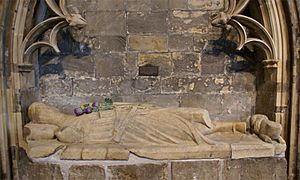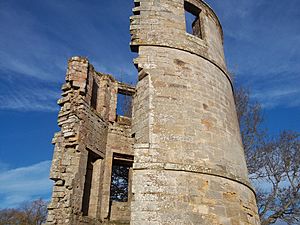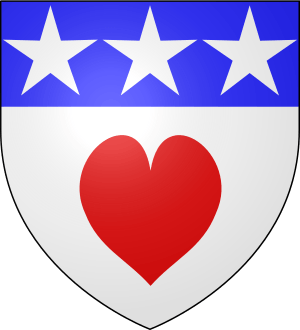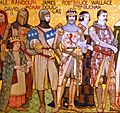James Douglas, Lord of Douglas facts for kids
Quick facts for kids
Sir James Douglas
|
|
|---|---|
 |
|
| Born |
Douglas, Lanarkshire, Scotland
|
| Died | 1330 Battle of Teba, Andalucia
|
| Occupation | Scottish Leader during the Wars of Scottish Independence |
| Spouse(s) | unknown |
| Children | William IV, Lord of Douglas Archibald 'the Grim' Douglas |
| Parent(s) | Sir William Douglas Elizabeth Stewart |
Sir James Douglas (also known as Good Sir James or James the Black Douglas) was a brave Scottish soldier and knight. He lived during the Wars of Scottish Independence and was a close friend of King Robert I of Scotland, also known as Robert the Bruce. Many people consider him one of Scotland's greatest heroes.
Contents
Early Life of James Douglas
James Douglas was the oldest son of William, Lord of Douglas. His mother was Elizabeth Stewart. James's father, William, refused to support King Edward I of England. Edward had taken control of Scotland in 1290. Because of this, the English king put William in prison and took his lands.
Young James was left without land and without his father. He went to France and lived a simple life for three years. When he heard his father had died, he returned to Scotland. He visited William of Lamberton, who was the Bishop of St. Andrews. The bishop took James in.
Later, Bishop Lamberton took James to meet King Edward I of England. The bishop asked the king to return the Douglas lands to James. But the king became angry and said no. The lands of Douglas had been given to Robert Clifford. The king did not want to talk about it anymore. James stayed with the bishop and did not rebel against the English king. He hoped to get his family's lands back.
But in 1306, Robert the Bruce claimed the crown of Scotland. Now James had a choice. He could support either King Edward or King Robert. He hoped one of them would give him back his lands.
Joining Robert the Bruce
In 1307, James Douglas decided to join King Robert against the English king, Edward I. That spring, James Douglas and some of his men attacked his father's castle, Douglas Castle. They defeated the English soldiers there.
Douglas then burned his castle. He destroyed all the wine and grain stored inside. He also poisoned the wells. The English soldiers they captured were put to death. This event became known as "Douglas' Larder."
Even though Douglas did not yet own his father's lands, he had great influence in that area. He and his men from Douglas bothered the English forces all that summer. Bruce and his followers, including Douglas, used special tactics. They made surprise attacks and then quickly escaped. They burned enemy lands and made captured castles useless to the English.
When Douglas learned that the Earl of Pembroke was bringing a large army into Scotland, he went to warn Robert the Bruce. Bruce and Douglas split up and agreed to meet later. When they joined their forces again, they attacked the English and won.
The Black Douglas' Reputation
In 1307 and 1308, James Douglas helped King Robert with several raids in southern Scotland. On the night of February 19, 1314, James Douglas and his men attacked Roxburgh Castle. They wore black coats to hide their armor. Roxburgh was the main English stronghold in south-central Scotland. It was defended by 100 English soldiers.
When Roxburgh Castle fell, many people in the area fled back to England. Douglas now held the castle. This event started his reputation as "the Black Douglas." To the people of Scotland, he was known as "the Good Sir James." He became one of the king's greatest supporters and a model of chivalry.
But James had black hair. His reputation was so feared by the English that they called him "the Black Douglas." They even said his amazing success against them was because he was a demon himself! His son and grandson also used this feared name, continuing the family's reputation.
Battle of Bannockburn
Edward II of England continued the wars against Robert the Bruce. He grew angrier with each Scottish victory. Determined to stop Bruce, he gathered a very large army. It included mounted knights, archers, crossbow-men, and foot soldiers. King Edward himself led this army. Its exact size is unknown, but it was much larger than Robert the Bruce's army.
King Robert chose the battle location at Bannockburn very carefully. He picked a spot with natural defenses. Many of these defenses stopped heavy cavalry or large groups of soldiers from moving easily. He organized his army into four 'battles' or Battalions. Three of these were 'hedgehog' or schiltron formations.
Just before the battle, King Robert knighted Sir James Douglas, his cousin Walter Stewart, 6th High Steward of Scotland, and many others. James and Walter were joint leaders of the left battalion.
When the English army was still approaching, King Robert sent Douglas and Sir Robert Keith, Marischal of Scotland to observe them. They reported that King Edward was coming with a very large army. During the battle, most of the fighting happened at the other two battalions. When the center battalion, led by Thomas Randolph, 1st Earl of Moray, was in trouble, Douglas went to help his close friend. But the English retreated before Douglas could reach them.
Finally, the Scots won the battle. The English fell back in confusion. King Edward, with 500 mounted knights, fled the field. James Douglas, with a small group of mounted soldiers, chased the English king. They chased them all the way to Dunbar. But Edward managed to escape back to England.
Raids on the English Border

After the English defeat at Bannockburn, the northern border of England was not well defended. In August 1314, James Douglas, along with Edward Bruce (the king's brother) and John of Soules, led a large raid into England. From 1314 to 1319, Douglas raided northern England at least once a year.
When Edward Bruce went to Ireland in 1317, Douglas took his place as the leader in southern Scotland. These raids were not just to frighten the English. They also aimed to get cash payment for the King of Scotland in exchange for not attacking a village. It was also to prove to the English that their king, Edward II, could not protect them. Douglas was one of the main leaders in the wars on the English border until the final peace in 1328.
Twice, in 1319 and 1322, when Douglas raided into Yorkshire, he tried to capture King Edward II and his wife, Queen Isabella of France. He did not succeed, but this only added to his reputation among the English as "the Black Douglas." On December 25, 1319, the Scots and English signed a two-year truce.
In 1320, James Douglas put his seal on the Declaration of Arbroath. This declaration of Scottish independence was a letter sent to Pope John XXII.
During this time, Douglas received many rewards, including grants of land. One special grant was not of land but of privileges. It was called the Emerald Charter. It gave James Douglas and his heirs freedom from many obligations to the king. It also made Douglas and his heirs a judge in their own lands. When giving James Douglas this special grant, the king took an emerald ring from his finger and placed it on Douglas's finger. His importance to King Robert and to Scotland grew over time.
The Heart of the Bruce
In 1328, Robert the Bruce was in poor health and was dying. One thing he had always wanted to do was go on a crusade to the Holy Land. He asked his friend Sir James Douglas to take his heart there after he died.
The king died on June 7, 1329. After the king's death, James Douglas had a silver casket made. He placed Robert the Bruce's heart inside it. He kept it safe on a chain around his neck.
In 1330, Douglas and six knights set out in a ship with royal banners. This was so everyone who saw it would know that the heart of Robert, King of Scotland, was on its way to Jerusalem in the Holy Land. The ship waited at Sluys, Flanders, for other knights to join them.
They sailed to Spain and stopped at Seville. They were welcomed by Alfonso XI, King of Castile and Leon. Many English knights who had come to Spain to fight against the Moors were also there. In August 1330, outside the Moorish town of Teba de Ardales, Douglas and his knights joined King Alfonso's army.
King Alfonso asked Douglas to lead the vanguard (the front part of the army). He placed all the English and Scottish knights under Douglas's command. Douglas ordered the charge, and the fighting began right away. When the Moors pretended to retreat, Douglas and ten of his knights chased after them. But it was a trick, and the Moors turned and surrounded them.
Trying to rescue a fellow knight, Douglas and all his knights were killed. Sir James Douglas was found with the silver casket still around his neck. His body was prepared for the trip home. The silver casket containing Bruce's heart never reached the Holy Land. It was buried at the Abbey of Melrose. Sir James Douglas was buried at the Kirk of Douglas.
Images for kids
See also
 In Spanish: James Douglas (señor de la guerra) para niños
In Spanish: James Douglas (señor de la guerra) para niños








